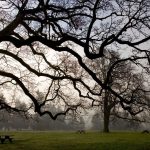Do Trees ‘Talk’ To Each Other? Yes, they do. Sorta.
Trees can talk to each other — and no, this isn’t some sort of fantasy land.
It’s understandable to think that it might be.
Trees talking?
In “The Two Towers,” the second part of Peter Jackson’s epic film trilogy of “The Lord of the Rings,” friendly little Hobbits Merry and Pippin, find themselves in an ancient forest. There they make the acquaintance of Treebeard, who is not a tree at all, but an Ent.
Of course, they don’t know that he’s an Ent at first. Or that he can talk. After all, Treebeard certainly looks like a tree — with a few notable differences — and trees can’t talk.
But he does.
“It’s talking, Merry!” says Pippin of Treebeard. “The tree is talking!”
Sure enough, Treebeard is talking — although as he explains quite huffily-puffily, “Tree?! I am no tree! I am an Ent.”
In Jackson’s fantasy world of Middle Earth — and the J.R.R. Tolkien novels from which the films were adapted — trees (or at least the beings that look like them) do indeed talk.
But here on Regular Earth, do trees talk to each other?
Yup.
Tree Talk
Yes, trees talk to each other — although “talk” is not the right word. Talking requires a mouth, and trees don’t have them. What trees do have, though, is the ability to communicate with each other. They do this in part via a fungal network that fills the spaces between them.
As reported on Smithsonian.com, “Trees of the same species are communal, and will often form alliances with trees of other species. Forest trees have evolved to live in cooperative, interdependent relationships, maintained by communication and a collective intelligence similar to an insect colony.”
How can this be possible?
The Science of Talking Trees
Scientists who study the vast symbiotic relationship and the rich underground networks of forest trees are often amazed by the complexity of this communication system. No matter the species — fir trees, Douglas firs, birch trees — the lives of trees are interconnected and intertwined.
According to ecologist Suzanne Simard, a professor in the Department of Forest and Conservation Sciences at the University of British Columbia in Canada, trees communicate by sharing resources. But there’s a lot more to it than that.
In fact, as other studies have shown, this network — cleverly dubbed the “wood wide web” — is comprised of “millions of species of fungi and bacteria (that) swap nutrients between soil and the roots of trees, forming a vast, interconnected web of organisms throughout the woods.”
Specific species of plants and trees utilize specific networks of fungi (or mycorrhizal) networks.
For example, ecologists and biologists studying the phenomenon have found that “oak and pine tree roots are surrounded by ectomycorrhizal (EM) fungi that can build vast underground networks in their search for nutrients. Maple and cedar trees, by contrast, prefer arbuscular mycorrhizae (AM), which burrow directly into trees’ root cells but form smaller soil webs. Still other trees, mainly in the legume family (related to crop plants such as soybeans and peanuts), associate with bacteria that turn nitrogen from the atmosphere into usable plant food, a process known as ‘fixing’ nitrogen.”
That’s all a rather complicated way of saying that trees are communicating — i.e., “talking” — to each other.
Communication and Cooperation
So what are these trees saying?
“It’s not just resources moving between plants,” Simard tells Yale Environment 360. “It’s way more than that. A forest is a cooperative system, and if it were all about competition, then it would be a much simpler place. Why would a forest be so diverse? Why would it be so dynamic?”
An example of this cooperation: If a tree is attacked by bugs, it releases chemical signals into the fungal network along the forest floor. Neighboring trees receive these chemical messages and increase their resistance to the buggy threat.
So while some may quibble with the idea that trees are “talking,” it is a fact that these chemical signals and the fungal networks along which they are transmitted make up a communications network.
“To me, using the language of communication made more sense because we were looking at not just resource transfers, but things like defense signaling and kin recognition signaling,” Simard says. “The behavior of plants, the senders and the receivers, those behaviors are modified according to this communication or this movement of stuff between them.”
About “kin recognition”: Simard examined what she calls hub trees or mother trees. Amazingly, she discovered that these older trees are able to recognize — and therefore favor — their own offspring in the seedlings that are sprouting around them.
“We found that they can,” Simard says. “That’s how we came up with the term ‘mother tree,’ because they’re the biggest, oldest trees, and we know that they can nurture their own kin.”
So the next time you find yourself — like Merry and Pippin — in a deep wood, remember that the ground beneath your feet is a complex communication network for the towering giants that shade your journey through the forest.
The trees are talking, Merry.
Inexpensive Tree Care in Portland
Are your trees telling you its time for service? Then contact Inexpensive Tree Care. Our tree care professionals are ready to serve you. Only experienced, reliable, licensed, bonded, and insured tree care experts work at ITC. We’ll deliver the best tree services in Portland, and we have the history and reputation to back it up.
Get in touch with us today!



